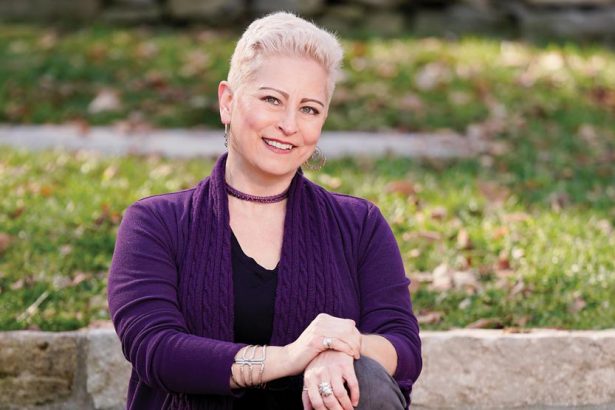Patient Search
 |
 |
|
KaCrole Higgins was diagnosed with breast cancer in 2020. “In May 2020, I found a lump in my breast. I cried. By June, it was diagnosed as breast cancer, triple positive, stage 1A. While getting this cancer diagnosis was devastating, it also became an opportunity. Suddenly, the cancer gave me clarity. It gave me clarity about what was important, what was good in my life, what was toxic in my life, and what I needed to do.” Click below to read more of KaCrole’s story |
If Landon Ryan had been diagnosed with bilateral retinoblastoma 10, 20 or 30 years ago, she might not be here today with nearly perfect vision.Thanks to recent improvements in the treatment for this rare form of cancer that almost exclusively affects children under the age of 5, the diagnosis had the power to change Landon’s life when she was 11 months old, but not to take it — or her eyesight. Click below to learn more about Landon and her story. https://momentum.vicc.org/2022/04/brighter-outlook/ |
Pembrolizumab after Radiation Therapy and Chemotherapy in Treating Patients with Limited Stage Small Cell Lung Cancer
Lung
Lung
This phase II trial studies how well pembrolizumab after standard treatment with radiation plus the following chemotherapy drugs: cisplatin or carboplatin, plus etoposide works in treating patients with limited stage small cell lung cancer (LS-SCLC). Immunotherapy with monoclonal antibodies, such as pembrolizumab, may help the body's immune system attack the cancer, and may interfere with the ability of tumor cells to grow and spread. Giving pembrolizumab after standard treatment with radiation plus chemotherapy may increase the ability of the immune system to fight LS-SCLC.
Lung
II
Whitaker, Ryan
NCT06140407
VICCTHO22114
Haploidentical Bone Marrow Transplantation in Sickle Cell Patients (BMTCTN1507)
Hematologic
Hematologic
This is a Phase II, single arm, multi-center trial, designed to estimate the efficacy and
toxicity of haploidentical bone marrow transplantation (BMT) in patients with sickle cell
disease (SCD). Based on their age and entry criteria patients are stratified into two groups:
(1) children with severe SCD; and (2) adults with severe SCD.
toxicity of haploidentical bone marrow transplantation (BMT) in patients with sickle cell
disease (SCD). Based on their age and entry criteria patients are stratified into two groups:
(1) children with severe SCD; and (2) adults with severe SCD.
Hematologic
II
Kassim, Adetola
NCT03263559
VICCNCCTT1759
An Imaging Agent (Panitumumab-IRDye800) for the Detection of Head and Neck Cancer During Surgery
Head/Neck
Head/Neck
This phase II trial studies the effect of panitumumab-IRDye800 in detecting head and neck cancer during surgery in patients head and neck cancer. Doctors who perform surgery for head and neck cancer are well-trained in removing all of the cancer that can be seen during the operation; however, there are times when there is cancer that is so small that it cannot be seen by the surgeon. Panitumumab-IRDye800 is a combination of panitumumab and IRDye800CW. Panitumumab works by attaching to the cancer cell in a unique way that allows the drug to get into the cancer tissue. IRDye800CW is an investigational dye that, when tested in the laboratory, helps various characteristics of human tissue show up better when using a special camera. Panitumumab-IRDye800 is a combination of the drug and the dye that attaches to cancer cells and appears to make them visible to the doctor when he or she uses the special camera during the surgery. Giving panitumumab-IRDye800 may help doctors better identify cancer in the operating room.
Head/Neck
II
Rosenthal, Eben
NCT04511078
VICCHN21109
Treatment Response and Biomarker-Guided Steroid Taper for Children with GVHD
Multiple Cancer Types
This phase II trial studies the treatment response for patients with acute graft-versus-host disease (GVHD). GVHD occurs when donor immune cells attack the healthy tissue of a bone marrow or stem cell transplant patient. The standard treatment for GVHD is to lower the activity of the donor cells by using steroid medications such as prednisone. But steroid treatment may cause many complications and the risk of these complications increases with higher doses of steroids and longer treatment. It is important to find ways to decrease the steroid treatment in patients who do not need long courses. Researchers are doing this study to find out how many subjects respond well to lower steroid dosing based on a blood test (GVHD biomarker) and if they develop fewer complications.
Miscellaneous,
Pediatrics
II
Kitko, Carrie
NCT05090384
VICCPED2213
Neuroblastoma Maintenance Therapy Trial
Multiple Cancer Types
Difluoromethylornithine (DFMO) will be used in an open label, single agent, multicenter,
study for patients with neuroblastoma in remission. In this study subjects will receive 730
Days of oral difluoromethylornithine (DFMO) at a dose of 750 mg/m2 250 mg/m2 BID (strata 1,
2, 3, and 4) OR 2500 mg/m2 BID (stratum 1B) on each day of study. This study will focus on
the use of DFMO in high risk neuroblastoma patients that are in remission as a strategy to
prevent recurrence.
study for patients with neuroblastoma in remission. In this study subjects will receive 730
Days of oral difluoromethylornithine (DFMO) at a dose of 750 mg/m2 250 mg/m2 BID (strata 1,
2, 3, and 4) OR 2500 mg/m2 BID (stratum 1B) on each day of study. This study will focus on
the use of DFMO in high risk neuroblastoma patients that are in remission as a strategy to
prevent recurrence.
Endocrine,
Neuroblastoma (Pediatrics),
Neuroendocrine,
Pediatrics
II
Pastakia, Devang
NCT02679144
VICCPED16157
Testing the Addition of an Anti-Cancer Drug, Irinotecan, to the Standard Chemotherapy Treatment (FOLFOX) after Long-Course Radiation Therapy for Advanced-Stage Rectal Cancers to Improve the Rate of Complete Response and Long-Term Rates of Organ Preservation
Rectal
Rectal
This phase II trial compares the effect of usual treatment approach alone (FOLFOX or CAPOX after chemoradiation) with using FOLFIRINOX after chemoradiation in patients with stage II-III rectal cancer. Combination chemotherapy regiments, such as FOLFIRINOX [folinic acid (leucovorin), fluorouracil, irinotecan, and oxaliplatin], FOLFOX (leucovorin, fluorouracil, and oxaliplatin), or CAPOX (capecitabin and oxaliplatin) use more than one anticancer drug that work in different ways to stop the growth of tumor cells, either by killing the cells, by stopping them from dividing, or by stopping them from spreading. FOLFOX or CAPOX are used after chemoradiation as usual treatment for rectal cancer. Giving FOLFIRINOX after chemoradiation may increase the response rate for the primary rectal tumor and lead to higher rates of clinical complete response (and thus a chance to avoid surgery) compared to FOLFOX or CAPOX after chemoradiation in patients with locally advanced rectal cancer.
Rectal
II
Ciombor, Kristen
NCT05610163
SWOGGIA022104
A Study of Combination Chemotherapy for Patients with Newly Diagnosed DAWT and Relapsed FHWT
Multiple Cancer Types
This phase II trial studies how well combination chemotherapy works in treating patients with newly diagnosed stage II-IV diffuse anaplastic Wilms tumors (DAWT) or favorable histology Wilms tumors (FHWT) that have come back (relapsed). Drugs used in chemotherapy regimens such as UH-3 (vincristine, doxorubicin, cyclophosphamide, carboplatin, etoposide, and irinotecan) and ICE/Cyclo/Topo (ifosfamide, carboplatin, etoposide, cyclophosphamide, and topotecan) work in different ways to stop the growth of tumor cells, either by killing the cells, by stopping them from dividing, or by stopping them from spreading. This trial may help doctors find out what effects, good and/or bad, regimen UH-3 has on patients with newly diagnosed DAWT and standard risk relapsed FHWT (those treated with only 2 drugs for the initial WT) and regimen ICE/Cyclo/Topo has on patients with high and very high risk relapsed FHWT (those treated with 3 or more drugs for the initial WT).
Pediatrics,
Wilms / Other Kidney (Pediatrics)
II
Benedetti, Daniel
NCT04322318
COGAREN1921
Study of INBRX-109 in Conventional Chondrosarcoma
Sarcoma
Sarcoma
Randomized, blinded, placebo-controlled, Phase 2 study of INBRX-109 in unresectable or
metastatic conventional chondrosarcoma patients.
metastatic conventional chondrosarcoma patients.
Sarcoma
II
Davis, Elizabeth
NCT04950075
VICCSAR2165
Evolutionary Inspired Therapy for the Treatment of Fusion Positive Newly Diagnosed, Metastatic Rhabdomyosarcoma
Multiple Cancer Types
This phase II trial investigates evolutionary inspired therapy in treating fusion positive rhabdomyosarcoma that is newly diagnosed and has spread to other places in the body (metastatic). Chemotherapy drugs, such as vinorelbine, vincristine sulfate, and actinomycin D, work in different ways to stop the growth of tumor cells, either by killing the cells, by stopping them from dividing, or by stopping them from spreading. Cyclophosphamide is used to decrease the body's immune response and may inhibit DNA replication and initiate cell death. This study is being done to determine which of 4 different therapeutic treatments will have the best chance of the disease not worsening or coming back.
Pediatrics,
Sarcoma
II
Borinstein, Scott
NCT04388839
VICCPED2134
Lower-Dose Chemoradiation in Treating Patients with Early-Stage Anal Cancer, the DECREASE Study
Rectal
Rectal
This phase II trial studies how well lower-dose chemotherapy plus radiation (chemoradiation) therapy works in comparison to standard-dose chemoradiation in treating patients with early-stage anal cancer. Drugs used in chemotherapy, such as mitomycin, fluorouracil, and capecitabine, work in different ways to stop the growth of tumor cells, either by killing the cells, by stopping them from dividing, or by stopping them from spreading. Radiation therapy uses high-energy x-rays to kill tumor cells and shrink tumors. Giving chemotherapy with radiation therapy may kill more tumor cells. This study may help doctors find out if lower-dose chemoradiation is as effective and has fewer side effects than standard-dose chemoradiation, which is the usual approach for treatment of this cancer type.
Rectal
II
Eng, Cathy
NCT04166318
ECOGGIEA2182



